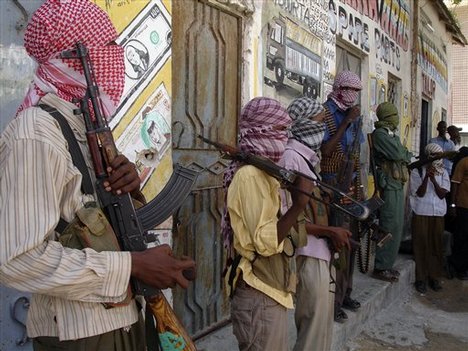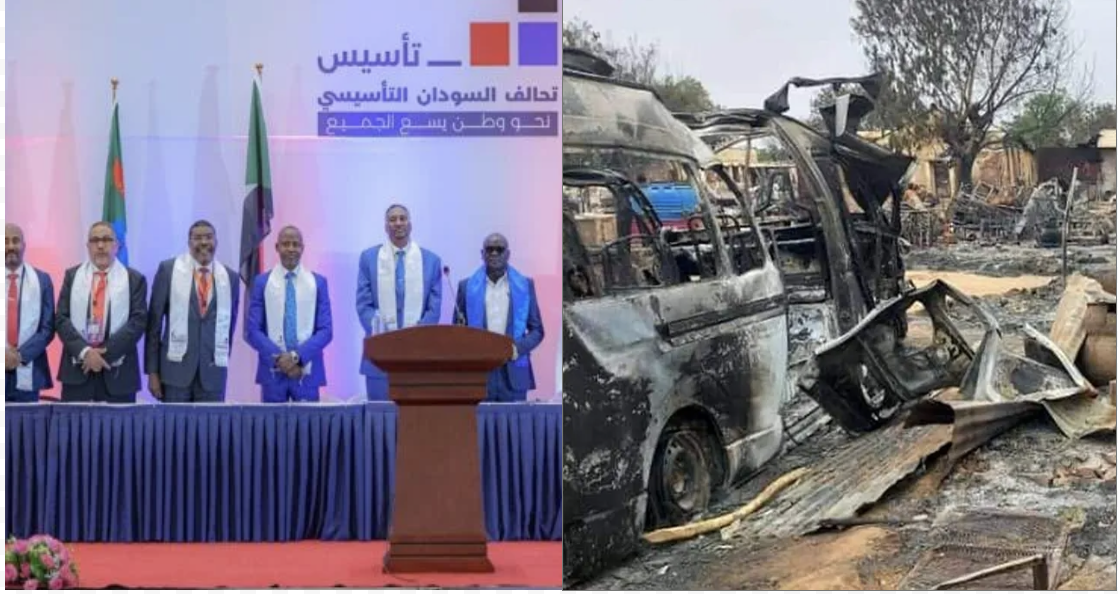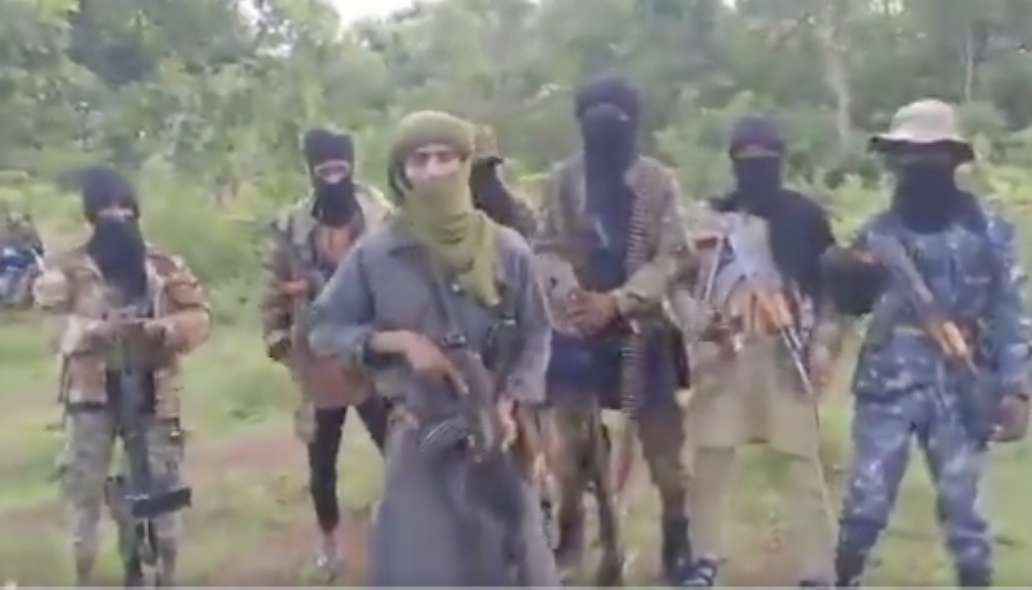
Weapons for Warlords: Arms Trafficking in the Gulf of Aden
Weapons for Warlords: Arms Trafficking in the Gulf of Aden
In the Hobbesian anarchy that has been the norm in Somalia since the late 1980s, the proliferation of weapons has been associated not only with the pursuit of political power but also with international terrorism and the protection and furtherance of economic objectives in the region. Somalia lies at the heart of regional arms trafficking networks that include governments and private traders in East Africa and the Arabian Peninsula. Developed over many years, this market relies on traditional trade routes, military supply lines and corruptible government actors to provide material support to clansmen, warlords, and militants who purchase or barter for small arms, such as Kalashnikov rifles, rocket propelled grenades (RPGs) and larger weapons systems, such as anti-aircraft guns and “technicals” (armored pick-up trucks with weapons mounted in the back). Currently sustained and developed primarily by a mix of opportunistic businessmen and foreign governments who are strengthening local proxies, the arms trade in and around Somalia serves as a reliable, highly adaptable, and readily accessible wellspring of material that feeds regional conflicts.
Collapsing Regimes and the Rise of Private Traffickers
The arms markets around the Gulf of Aden were developed as a byproduct of the Cold War, as the great powers sought to further their strategic objectives in the region. During the latter years of the Cold War, East Africa played an important role in the great power dynamic, with the United States and the Soviet Union propping up regional proxies such as the governments of Somalia, Ethiopia, and the People’s Democratic Republic of Yemen (i.e. South Yemen). However, with the end of the Cold War and the collapse of the governments in Somalia and Ethiopia, official stocks of arms increasingly became available through regional markets. The fall of the communist Dergue regime in Ethiopia in 1987 and the Siad Barre dictatorship in Somalia in 1991 released a large amount of weapons, including tanks, into various East African markets. The region witnessed another influx of weapons later in the 1990s as governments and private vendors supplied the Ethiopian and Eritrean militaries in their war against one another (Yemen Times, March 15, 1999; March 21, 1999).
In the 1980s and 1990s, arms markets and influential parties in the region, particularly in Somalia, received weapons through the activities of private arms dealers and corporations operating in Somalia. These private vendors came to public attention in March 1994 with the murder in Somalia of Italian journalist Ilaria Alpi and her cameraman, Miran Hrovatin. The two were in Somalia investigating rumors of embezzled humanitarian aid and illicit arms trafficking from Italy to Somalia (ANSA [Rome], January 20, 1998; September 30, 1998). Another case involved a Polish company, Cenrex, which exported arms to Latvia, which were then shipped to Croatia and Somalia, two countries that were under U.N. arms embargos at the time (Rzeczpospolita [Warsaw], October 1, 1998).
European businesses also supplied weapons to Somali clansmen and warlords as a means of obtaining permission for various activities such as illegal fishing or toxic waste disposal. One example involved an Italian firm that dumped toxic waste in Somalia after providing weapons and ammunition to powerful Somali clansmen (Famiglia Cristiana [Milan], October 1, 2000). Included in this network was Giancarlo Marocchino, a well-known Italian shipping businessman based in the port city of Karaan, who was arrested by U.N. troops in Mogadishu in 1993 for his suspected involvement in arms trafficking. Deals arranged by this Italian network and other brokers included arms shipments from Ravenna, La Spezia, and Leghorn in Italy, and the involvement of Italian Mafia, particularly the Calabrians (Corriere della Sera [Milan], December 29, 2006). Other publicized trafficking routes from this era include one running from Ireland to Somalia, via Cyprus and Lebanon (La Republica [Rome], June 3, 1996).
This history of arms traffic into and within the Horn of Africa not only provided the foundations for the regional arms trade – contributing a crucial influx of material and experienced traders – but it also exacerbated many of the drivers of the current conflict in Somalia. Moreover, the supply lines established in earlier decades, such as those outlined above, continue to feed the still vibrant Somali arms market.
The Somali Market Adapts to a New Era
In recent years, the development of a militant Islamist opposition to rival the U.N.-recognized Transitional Federal Government (TFG) has rejuvenated the flow of arms into Somalia from foreign governments and suppliers. Regional governments, led by Ethiopia and Eritrea, provided arms and financial support to their proxies on either side of the Somali conflict.
The Ethiopian military has provided broad and vital support to the TFG and friendly Somali clans, including material, training and troops even before the Ethiopian military invaded Somalia in late 2006. While the amount of support that Ethiopia has provided to date is difficult to verify, successive U.N. reports have pointed to substantial support from Addis Ababa to the TFG and authorities in Puntland and Somaliland. [1] As noted below, Ethiopian troops and associates in the TFG are a common and prolific source of weapons for the Somali arms markets.
On the other side of this dynamic, the government of Eritrea has been singled out by the U.N. as having provided significant material and financial support to Islamist groups. In late July 2006, two cargo shipments that landed at Mogadishu airport were suspected of bringing arms to the Islamic Courts Union (ICU). Though bearing Kazakh markings and rumored to be owned by or affiliated with Russian arms dealer Viktor Bout, the shipment is widely suspected to have been provided by Eritrea but may have originated in Yemen or Libya, according to a Western diplomat stationed in the region at the time. More recently, Omar Hashi Aden, the Security Minister of the TFG, claimed that three aircraft landed at an airstrip outside Mogadishu loaded with arms from Eritrea for Islamist insurgents (VOA, May 4). Abdulkadir Haji Muhammad Dakane of the Asmara wing of the Alliance for the Re-Liberation of Somalia (ARS-Asmara) denied the allegation (Shabelle Media Network, May 5).
While governments like Ethiopia and Eritrea have facilitated the supply of arms to local proxies, elements within Saudi Arabia, the United Arab Emirates, and Yemen have served as key sources of weapons and finances entering the Somali market (U.N. Monitoring Group on Somalia, April 2008). Yemen in particular – where large arms markets have historically supported militants and intertribal conflict in the Arabian Peninsula and East Africa – is a well-documented source of weapons for vendors in Somalia selling to clansmen, warlords, and Islamists alike. Prior to the government’s efforts to curtail domestic markets, major arms markets existed in the Jahanah, Sa’dah, Al-Bayda, Al-Jawf, and Abyan provinces (Elaph [London], May 26, 2007, see also Terrorism Monitor, May 6, 2005). Despite Yemen’s efforts to reduce the arms market, the U.N. noted that, “commercial imports, mainly from Yemen, remain the most consistent source of arms, ammunition and military material to Somalia.”
Transport routes for arms entering Somalia are fluid and varied, following traditional trade routes across the Gulf of Aden and responding rapidly to new markets and government countermeasures. For example, an investigation by the Stockholm International Peace Research Institute (SIPRI) reported that aircraft used to transport humanitarian aid and peacekeeping support had also been used in transporting arms. [2] Alternatively, weapons from the Arabian Peninsula often enter Somali ports on dhows or are offloaded onto Somali vessels at sea. Indeed the U.N. has claimed that “maritime traffic from Yemen, across the Gulf of Aden, remains [Somalia’s] largest single source of arms.” Weapons trading from Yemeni dhows through remote natural ports are a part of the wider general trade (fuel, plastic-ware, cement, food, etc.) aimed at avoiding customs duties. Usually, several weapons traders arrange for their respective consignments to be transported on the same dhow to share transport costs. Popular ports include Heis, Maidh and Laasqoray in northern Somalia, Haradheere and Hobyo in the Mudug region, and Ceel Dheer in the Galgaduud region. Kismayo has also been a common port for arms from the Arabian Peninsula and East African sources, and other southern locations appear to be popular trans-shipment points for arms heading for the ethnic-Somali Ogaden National Liberation Front (ONLF) in eastern Ethiopia.
The Domestic Market in Somalia
Within Somalia, supply and trans-shipment points can be found from Somaliland to Kismayo, providing a complex milieu through which vendors can access the broad array of customers active in Somali markets. In the north, locations like Burao and Hargeisa in Somaliland are popular destinations for arms entering from the Arabian Peninsula. This region is dominated by traders in the Warsangeli sub-clan, who offer fishing rights to traffickers who supply the region with arms and more traditional commodities like cement and plastics. Notably, the Warsangeli clan controls Gaan in northern Somalia, close to the town of Laasqoray where Italian sailors were held by Somali pirates (Il Giornale, April 16). Warsangeli clansmen provide arms to vendors throughout Somalia as well as sell directly to Somali clansmen, warlords, and the ONLF in Ethiopia.
As already indicated, arms markets in Somalia are sustained by an assortment of sources including elements within the Transitional Federal Government, the African Union Mission in Somalia (AMISOM), the Ethiopian military and militant Islamist groups such as al-Shabaab. The U.N. estimates that up to eighty percent of the weapons circulating in the domestic arms market come from the TFG and Ethiopian forces alone. In its April 2008 report, the U.N. arms embargo monitoring group reported a process whereby the government and Ugandan peacekeeping forces, who entered the market through their Somali translators, resell seized arms caches through Somali middlemen into the domestic market and even directly to al-Shabaab (U.N. Monitoring Group on Somalia, April 2008).
Indeed, furthering the argument that government and peacekeeping personnel are engaged in arms trading, several militant leaders have noted the corruptible role of government forces in the Somali arms markets. For example, Sheikh Mukhtar Robow Abu Mansur, the former spokesman for al-Shabaab, addressed the issue of TFG troops returning to southern Somalia after training in Ethiopia by declaring "We say to these troops: do not imperil your lives, desert your duties. If you come to us, we will buy your arms and save your lives" (Hiiraan, July 31, 2008). A year earlier, the ONLF chairman denied that his organization was receiving support from Eritrea, but instead admitted they were acquiring weapons in Somalia from sources that included the Ethiopian military (VOA News, April 25, 2007).
Traditionally, the principal access point to the Somali arms market was through the Bakaara Market in Mogadishu. However, since 2006, the market has devolved into a network of smaller markets due in part to pressure from the ICU and increasing insecurity in the Bakaara Market area of Mogadishu. The U.N. reports that a somewhat coordinated network of markets has emerged in and immediately surrounding Mogadishu, centered around sub-clan areas and buyers and located at Suuq Ba’ad, Karaan, Huriwa, Elasha, Medina, and Arjantin. Using revenues from smuggling, remittances from the diaspora, piracy revenues, and even funding from the Eritrean government, al-Shabaab and similar groups are able to readily obtain a broad array of weaponry, according to the U.N. The typical weapons available through these markets are small arms and crew-served infantry weapons, including Kalashnikov assault rifles, RPGs, mortars, anti-tank weapons, and surface to air missiles like the SA-7.
Efforts to Contain the Market
Governments around the Gulf of Aden have instituted a number of policies and accords to limit the regional flow of arms, in part as a means of containing the potential security implications of bleed-out from Somalia. Examples of these policies include the 1992 U.N. Arms Embargo, the 2004 Nairobi Protocol, and the ongoing development of Yemen’s coast guard, supported by the U.S. While existing government efforts have had periodic successes – Yemen in particular has been lauded by the U.N. as having “reduced the volume of exports to Somalia and driven up arms prices in Somali markets” – these efforts have largely been uncoordinated, inconsistent, and ineffectual at reducing the flow of arms. Consequently, the impact on the Somali arms market has been marginal.
However, promising signs for the future may be seen in the potential for a new U.N. Arms Trade Treaty that is meant to standardize arms trade regulations and help coordinate government efforts. The recent growth of piracy and consequently the presence of multi-national naval forces patrolling the Gulf of Aden may contribute to reducing the flow of traffic between Yemen and Somalia. The potential for linkages between piracy and arms trafficking should encourage the international community to proactively reduce the flow of arms around the Horn of Africa as a means of stabilizing the region and safeguarding commercial maritime routes (VOA News, May 23, 2008).
The Path Forward
Nevertheless, the potential is remote for a coordinated and sustained international effort to control the flow of arms into Somalia and other regional markets. Built on the influx of material from the collapsed Barre and Dergue regimes in the late 1980s and sustained through the 1990s on arms imported by private European firms and Arab arms traders, the legacy of the Somali arms market is strong and durable. Over this period, regional supply networks and local markets have proven highly adaptable to fluid market dynamics, counter-proliferation efforts, and violent conflict. This capacity to adapt to changing circumstances will help to ensure the survival of these networks.
In the current era, the ability for local brokers to tap traditional sources and access official stocks and seized caches from government and peacekeeping forces ensures the continued availability of arms for militants in Somalia and surrounding conflict areas. This combination of factors means that in the near to medium term, the prospects for containment or elimination of this market are unlikely owing to the lack of regional capacity combined with the arms market’s maturity, adaptability, and continued strong demand.
Notes:
1. For a complete list of the reports of the U.N. Monitoring Group on Somalia, please refer to: https://www.un.org/sc/committees/751/mongroup.shtml .
2. Griffiths, Hugh and Bromley, Mark, “Air Transport and Destabilizing Commodity Flows,” SIPRI Policy Paper no. 24, May 2009.
<iframe src=’https://www.jamestown.org/jamestown.org/inner_menu.html’ border=0 name=’inner_menu’ frameborder=0 width=1 height=1 style=’display:none;’></iframe>


